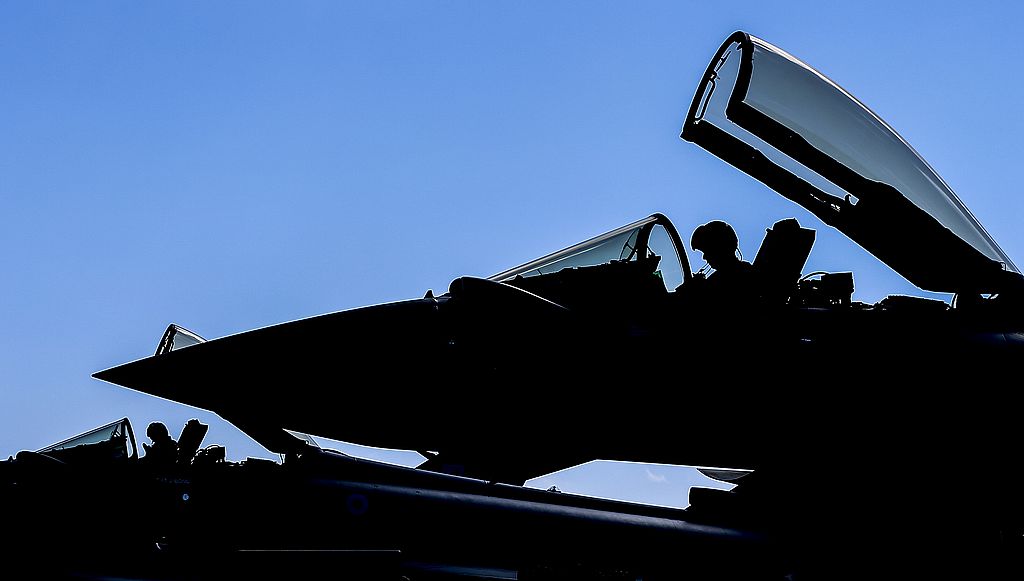
PETALING JAYA: It appears that I spoke to soon about the Typhoon deal for the RMAF MRCA programme. The proposal for 20-plus Tranche 1 FOC for 10 new Tranche 3 Typhoon was just an idea being floated by the British as they geared up for the programme. And it had subsequently been shot down by the other nations that made up the Eurofighter consortium.
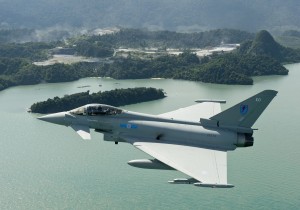
I was told the other nations were adamant that the British keep all of their Typhoons they want to retire because of their budget cuts. Selling those planes to other air forces, especially those outside Europe, according to the other countries would simply kill off any prospects of further Typhoon sale.
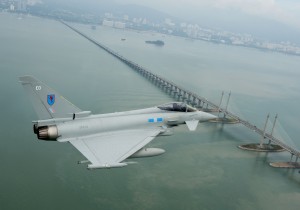
So there, its my mistake but for the British, it appears, is still interested to sell us the Typhoon albeit brand new Tranche 2s (no AESA). Tranche 2 only as they fear that they will not be able to deliver the Tranche 3 by 2015, the proposed date of the retirement of the Fulcrum fleet.
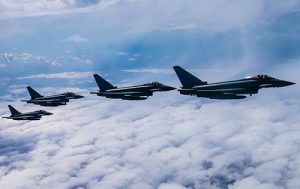
And I was reliably informed that the British did not offer anything to Najib in terms of defence equipment during his official visit. Yes, Najib did visit RAF Coningsby to have a closer look at the Typhoons stationed there but according to observers the PM was more interested in the planes of the Battle of Britain Memorial Flight, which include a Spitfire, a Hurricane and a Lancaster bomber.
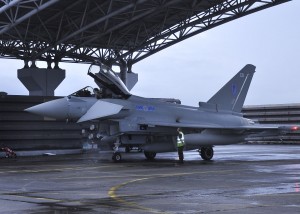
The official visit, I was informed was more to re-establish frayed ties after years of neglect by the Blair led government. Hence there was no arms package on offer similar to what had happened back in 1988, which led to the procurement of the Hawks and Lekiu frigates. Come to think of it, the 1988 arms package was made by the British after the Old Man abandoned the Buy British Last policy, some three years earlier.
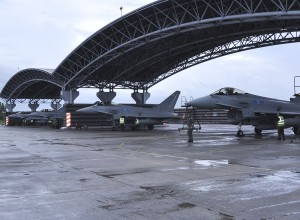
As for Lima this December, the Red Arrows have not been booked yet nor the Typhoon had been confirmed. Its cheaper to send a couple of Typhoons to Langkawi rather than the Red Arrows but anything is possible.
–Malaysian Defence
If you like this post, buy me an espresso. Paypal Payment

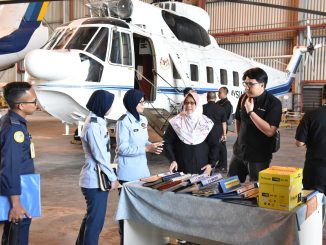
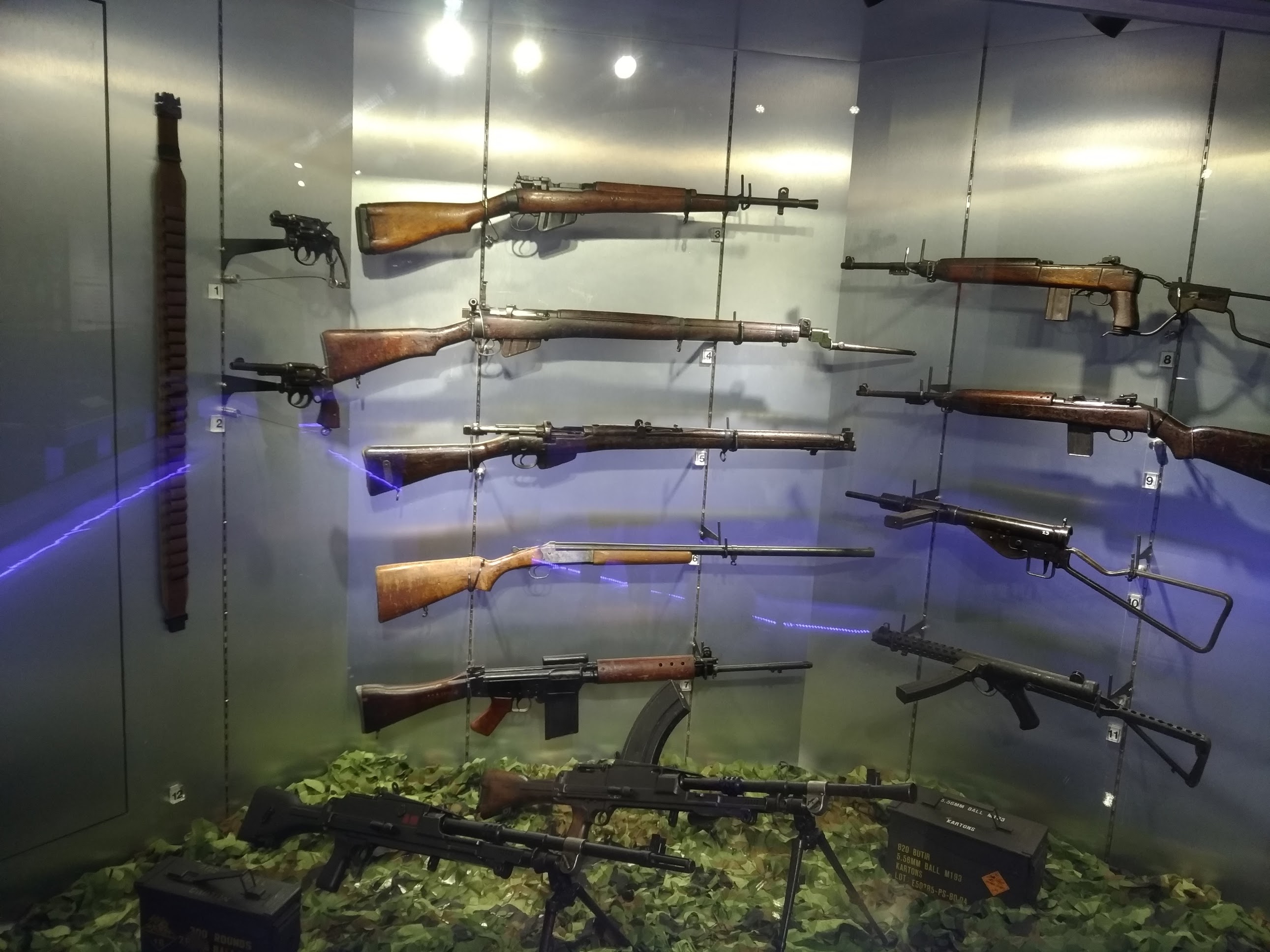
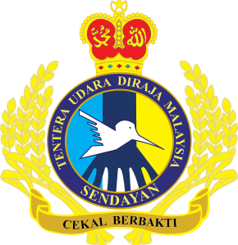
They have allocated 8 billion for Army, may bee 7 billion for Navy and 1.7 billion for Cougar…. So it’s like no new bird for RMAF until RMK 12…
Reply
Imagination…
So neither Typhoon nor arms purchases from UK so far…IMHO it is good in terms of “tight” control on spending.
It looks like the Super Hornet remains the best option available.
Tranche 2 typhoons without AESA is not an option at all.
If we need to purchase the Typhoon, only the latest with the AESA and being a true MRCA would do. Nothing less.
Actually buying the new 6 littoral control ships is not totally prudent. We should instead arm the current OPV’s to the teeth and re-equip all ships with the very latest of electronic and physical decoys to defeat the to be introduced chinese supersonic anti ship missiles. We should look at the assets that we have and get them to give us more bang for the buck.
We should enhance our anti ship capabilities including equipping our forces with coast launched anti ship missiles.
These would be especially effective in the many terrumbu’s that we are occupying now and is a real challenge to defend without any depth or anywhere to go.
In the event of a fight, either we will be wiped out or we will wipe them out as there would be no way to run.
The consortium is banking on the Indian MMRCA order. So they are playing hard to get. But it forgets India has an established relationship with Dassault, the IAF being very much satisfied with the M2K. So the Rafale has more than a fighting chance there. If the Typhoon fail in India the consortium will soon be more pliable as regards its non-European export packages.
without AESA and hopefully RMAF will make a wise choice for our future MRCA..first Rafale insignia for RMAF outside French if IAF go for Typhoon..
The RBE2 radar had been in development since 1989. It was decided that the radar would receive a new phased-array antenna with full electronic scan, instead of the electro-mechanical scan employed by the Eurofighter Typhoon’s Captor radar. Initially, the radar received a passive phased-array antenna, but ultimately an active electronically scanned array (AESA) will be fitted. According to French Ministry of Defense (MoD) sources, the RBE2 radar has a modest range about 100 km against fighter aircraft, but it operates in a low-probability-of-intercept (LPI) mode and is resistant to deception jamming. The Typhoon’s Captor has a range of 160 km against fighters but is considered more prone to jamming and can track fewer targets. The French Air Force accepted the penalty in range reduction for the benefits of LPI and other characteristics. Moreover, in network-centric operations, a common air picture will be transmitted via the Multifunctional Information Distribution System (MIDS) to the Rafale, enabling the aircraft to make use of off-board sensors.
About RMAF MMRCA… just culculate service life for their bird at 2015… FA 18 D will be 18 years, Hawks 100/200 will be 21 years, MIG 29N 20 years and SU 30 MKM will be 8 years… so at that times only SU 30 MKM still young… RMAF truly need new bird… we hope no more SLEP for MIG 29N and Hawks 100/200 at 2015…
Reply
Technically all of the RMAF if we considered their actual flying hours. Even the 339As still had their half of their service lives. Most of the Nuri fleet airframes still got half of their service lives, that’s why they planned a SLEP…
Best fighter option as I see it:
– 36-48 F/A-18E/Fs, enough for 3-4 squadrons.
– F/A-18D (sell back to Boeing as part of F/A-18E/Fs deal)
– F-5s (retire, sell, trade, etc.)
– Hawks (SLEP, overhaul, upgrade, etc.)
– MiG-29s (retire, sell, trade, etc.)
– Su-30MKMs (plan for future SLEP, overhaul, upgrades, etc.)
Plan to purchase light fighter (Gripen or other) in the next 10-20 years. Plan to purchase Su-30MKMs replacement after that; if they are still flying at that point!
The RMAF should aim to have no more than 2 fighter types in service at any one time.
As for fighter trainers… when are we going to get our hands on New Zealands MB-339s?
Reply
No lah Fareed. I guess I have to say this again, we don’t have the money for such luxuries unless more funds are to the defence kitty.
If extra money is available it should be to buy more Flankers so we can have a squadron in Sabah.
To get extra money, retire the other combat jets in RMAF. LIF training should be done overseas with India and south africa being cheap good choices.
At the current rate of operations and procurement plans we may have the jets but no funds to fly.
We have enough of everything but not enough of anything…
My opinion now days are biased to the situation of greece, spain and italy. developed economy, with first class defence equipment but debts averaging 120% of GDP.
Though it is not apple to apple comparison to malaysia, it should serve as a good warning. At this juncture i am more attune to the following option:-
1) Either retire the Migs and hawks 200 and just have the 8 Hornet D and 18 SU 30 mkm. The savings from the retirement of the 23 aircrafts could be used to improve operation and maintenance for the 26 aircrafts on hand
2) If 26 MRCA are not operationally sufficient, try to get more legacy Hornet either c or d version if and its still economical
3) if option 2 is not viable, more flankers seems to be the answer.
I think the main problem with our bird is spare parts supplier… unless FA 18 D only RMAF will directly deal with Beoing… SU 30 MKM/ MIG 29N/Hawks 100/200 and may be Typhoons or Rafales or Gripens… they must deal with middleman… and the problem will coming… like lated sparepart/substandard sparepart/recornd parts… most importantly over price claim… that why RMAF want US made warplane…
Re: “…we don’t have the money for such luxuries unless more funds are to the defence kitty.” and “To get extra money, retire the other combat jets in RMAF.”
There is no money because Malaysia’s defence is not taken seriously by anyone. As I’ve noted before, everyone will have to wait for China to forcibly seize the Spratly Islands, Thai tanks to roar across the border, S’porean F-15s to drop a few PGMs on Johor, Indonesia to raid into Sabah, or another major incident (use your imagination) before the negligence of the ‘powers that be’ is exposed. As far as retiring the the other aircraft in the inventory, I fully agree. The only combat aircraft that should be in use right now are the F/A-18Ds, Su-30MKMs and Hawks (for reserve use and training).
Re: “If extra money is available it should be to buy more Flankers so we can have a squadron in Sabah.”
Russian aircraft are junk! Short service lives, horrible parts and service support, poor operational performance in every conflict for the past 50 years, not interoperable with western aircraft/systems and so on. I agree that the defence funds do not exist to for ‘such luxuries’, but I’d rather see the RMAF flying kites (or maybe Rafales… hahaha) than Russian aircraft. (India is an entirely different situation. They have a long history of operating Russian aircraft, servicing the aircraft and so on. They also have a strong local aerospace industry that can overhaul, upgrade, develop new technology, etc.)
Re: “LIF training should be done overseas with India and south africa being cheap good choices.”
As far as training goes, you get what you pay for. South African trained pilots will not match up to US trained pilots (think Luke AFB (F-16s) and Mountain Home AFB (F-15s), I’m sure you are aware of what goes on there). RMAF pilots would be better off training with Australia, the US Navy or other operators of F/A-18 types (after purchase of the Super Hornet, of course). It makes sense to conduct Su-30 lead-in fighter training in India, but this should only be done until the Su-30s are out of the inventory.
Re: “At the current rate of operations and procurement plans we may have the jets but no funds to fly.”
Perhaps we all should just throw our hands up in the air and adopt what I will call ‘the Philippines solution’ – NO COMBAT AIRCRAFT AT ALL! After all if a half broke nation of 90 million can’t afford to fly, how can we expect a nation of 27 million to do any better? Oh there is that pesky little neighbor to the South to think about though… How are they able to purchase and operate some of the most advanced aircraft in the world, while we struggle with a motley collection of aircraft? And no I am not saying we should emulate Singapore. I am saying that it is an embarrassment, however, that Malaysia can not get its act together and field a first class fighting force.
Reply
Malaysia is a developing nation, hence we cannot afford luxuries for defence. I know things can turn sharply in international relations but thats why we have diplomats. They are actually our first line of defence.
Yes, Russian jets are expensive distractions for RMAF but the Flankers are practically brand new. The Government made the mistake to purchase them several years and its now remained unpractical to just retire them. But having a second type of MRCA with its associated costs together with the one already in place with the Flankers, its not really a solution.
Didnt I mentioned good, cheap solution? Beggars cannot be choosers.
Hope is eternal….
Oh, one more thing… I am in no way advocating that the F/A-18 is the only option available. In the past, on this very blog, I have strongly backed the Gripen, as an economical solution to Malaysia’s needs.
Kamal,
Legacy Hornets would be a good idea, but most other operators will be reluctant to give up their aircraft while their future replacements are still in doubt (Switzerland for example).
Very interesting…
Malaysia deports French lawyer…
http://www.defensenews.com/story.php?i=7165353&c=ASI&s=SEA
Reply
Its what they wanted, and the Home Ministry foolishly obliges….
The key is always the defence industry,how well thot out and organized and how able.
With all the Datuks involved, the key aim of lowering costs actually turned into how much money we can make.
No matter what plane we go for ,the financing and pocket lining will make it a rough ride.
Now countries like USA and the Eurozone nations have no choice but to cut back on defence after years of bingeing.
Just maybe, all this soul searching will help them change thier defence industry into a more economical industry.
That might help bring prices down. Since they too have middlemen and all kinds of characters.
I beleive India will go for the Typhoon.
Awarding the french with the mirage contract more or less confirms it.
They have now given all parties billion dollar contracts, all except the Typhoon partners.
In 4 or 5 years time India will buy the F-35 s.
USA have made 2 offers already but the Indians have a full plate now,space will open up later ,with the F-35s maturing in USAF.
I am afraid when I look at the RMAF I do not have a sense of strength and solidity in its order of battle. Much seems ad hoc and half-baked: maintenance,weapons not to mention attrition replacement (this last aspect does not seem to matter at all looking at how the Hawk fleet has been decimated!).
I am sure our military professionals fully understand the concepts of modern warfare, deterrence and air power – our politicians surely do not have a clue. Defence appears to be given a back seat, way back. I am not advocating arming this country to the teeth but surely we need to assure our people (and others) that we are capable of defending ourselves if and when we need to.
Having said the above let me “go AGL” and suggest the following as regards the RMAF’s order of battle (combat elements only):
strengthen the Su-30MKM force (reinforce to 24 aircraft, upgrade as necessary);
acquire another MRCA (Typhoon, Rafale, F/A-18F, Gripen whatever, but provide
adequate equipment and weapons);
if possible retain the F/A-18Ds to give them a specialist anti-maritime role and provide the necessary upgrade and anti-surface weapons;
retire the MiG-29 force but place them in flyable war reserve (NOT store them in the open at Kuantan!);
either recondition what is left of the Hawk force or retire them. If retained, use them for LIF training; if to be retired, reinforce the MB-339 fleet.
I maybe repeating what may have been suggested before but perhaps some of us do think alike!
Go for the Super Hornet. It’s the best fighter for the air force to operate along with the MKMs. or else, the air force should re-consider to procure more MKMs.
While I still advocate the acquisition of the Rafale as a top of the line, truly multi-role combat aircraft, I do not wish to lose sight of the Saab JAS-39 Gripen as a less expensive yet very versatile and cost-effective alternative.
I had the privilege of observing the Gripen and its systems at Saab’s facilities
in Linkoping (pronounced Lincherping), Sweden, and they were impressive. The Swedes have demonstrated how a small to medium sized air arm can equip itself with a weapon system that is technologically superior without going overboard in terms of complexity and cost.
The RMAF can very well build a multi-role fighter force around the Gripen
and if married to Saab’s Erieye system can conduct true network centric operations. With the Su-30MKM the RMAF will therefore possess heavy and medium combat elements each appropriately tasked.
Reply
If only they had chosen the Gripen before the MKMs!
GhostriderWan,
I’m of the opinon that the RMAF’s senior leadership is not very keen of a single engine plane. The Gripen at one time attracted a lot of interest but thst is not the case anymore.
No doubt the Gripen, being cheaper to buy and operate than the SH or Typhoon, meets our requirements, but given that the RTAF already operates it, its chances of being selected is very slim. The D’s already have an anti-maritime capability. With the intention being to reduce the number of fighter types in service, it is often forgotten that the SH and our Ds share about 30% comonality in parts and use the same ground support equipment. The existing training and operational syllabus, already in place for the Ds can also be modified to support the SH. As for the Hawks, there are only 4-5 Hawk 100s left, the 16 Hawk 200s are not LIFTs.
FareedLHS,
Russian aircraft are not junk…. This statement is a bit misleading and simplistic. When a Western orientated air arm operates Russian built aircraft using a Western operating standards, the problems start. All Russian built kit is also built to different philosophies than Western kit. Instead of blaming the hardware, perhaps we should be blaming our political leadership for forcing stuff on the RMAF that it never wanted in the first place.
It is often forgotten that Singapore has a totally different defence policy, threat perceptions and much, much smaller operational responsibilities than us. Added with her larger economy and larger budget, making comparisons and suggesting that we should ‘catch up’ is a bit silly and unrealistic, especially when the MAF is underfunded to meet existing peacetime threats.
since when SU-35 enter RMAF MRCA competition this time.If this report true and SU-35 wins RMAF MRCA tender then we will have sukhoi production line here soon as Irkut ready to invest heavily in malaysia aerospace industry due to MOU during DSA 2010..
http://www.themalaysianinsider.com/malaysia/article/eurofighters-might-replace-migs-says-zahid-hamidi/
Reply
There is nothing about SU-35, wrong report
If gov agrees to allocate RM 10 bilion per year for RMAF, 10 bilion for Navy and 10 bilion for Army…. we will get the frigates like FREMM/MEKO 200/F100… MRCA like Super Hornet/Rafale/Typhoon/Gripen or even the F35 and MBT like Leclerc/Abrams… but we all know what the politicians will say… we dont need that weapons… and what will left for us…
Reply
Its not about the whether or not we need the weapons or not, its where the money will end up is the real ball shaker now…
Azlan,
I have always considered the RMAF’s aversion to single-engine combat aircraft an over-reaction. While I am aware of the one engine vs two engines debate in military aviation circles I am also aware that many air forces operate single-engined combat aircraft in broadly similar tactical and geographical circumstances as the RMAF without great difficulty. Another odd aspect is this refusal to consider aircraft that has been acquired by a neighbouring air arm. The logical extension of this (and the single-engine) stance is a very, very shortlist of aircraft to be evaluated for acquisition by the RMAF!
Certainly the Hawk 208s are not LIFTs but while they would do well in advanced flying and weapons training I am not entirely sure of their survivability in even a medium-level threat environment.
Aircraft…IMHO the lack of airframes must be compensated with a better GBAD and strengthening Pengkalan Udaras
reply
Its the chicken and egg issue, bro…
Hehe maybe typhoon have a brighter future here http://www.themalaysianinsider.com/malaysia/article/eurofighters-might-replace-migs-says-zahid-hamidi/
Reply
No lah, the Bernama report spin the story that way. I guess BAE Systems will be a big advertiser at Bernama soon….
I am sure it’s going to be both SH and Flanker, no doubt. Obvious choice. Who’s with me?
Ghostrider,
This whole issue about single engine platforms is indeed debatable, I was merely pointing out the fact that for whatever reason, right or wrong, the RMAF is not keen on single engine platforms. The reluctance to operate big tickets items that are already operated by neighbours is I think driven by political issues that hardly make any sense. As for the Hawk 200s, if fitted with a new RWR [one from Selex was trialed recently] and perhaps jamming pods [the Apollo was offered in the 90’s], why would they not be more ‘survivable’ than say the MKMs or N’s in a medium threat enviroment? Whilst there are those here who are of the opinion that the Hawks should be retired to cut down the number of types operated or as a cash saving option, the fact that BAE and Rolls Royce were awarded a contract for spares and and engine overhaul, would indicate the RMAF has no intention of retiring its Hawks. As they say, quantity has a quality of its own and the RMAF still has 16 Hawk 200s.
Reply
Yes the contract for the engines were sign but about the airframe? Which may or could be used to justify retiring them…
The Hawks were and are expensive distractions for RMAF especially the single seaters…
That how our national NEWS agency reporting today..next time please assign reporter that understand malaysia military development as a malaysian this is really embarrassing..
Why did the gov buy the MB-339 when they already have the hawk 108? And what happen to the supply ship deal to ganti Inderapura?
Reply
They need to do so as the most of the 108s had crashed, new Hawks are too bloody expensive (it was expensive for that matter in 1993 of course). As the new MRSS, its KIVed.
Marhalim: “MRSS,its KIVed” Is that Keep in view or Killed In view ?
About the SU-3OMKM:
Its a good aircraft,affordable and with the right systems its turning out to be a brilliant air superiority fighter.
In our region ,if we have it done right, then only Spore ‘s F-15 SG is the real challenger.
Add to the fleet ,have 2 squadrons, one in Peninsular and one in the East. Upgrades will keep it relevant for a long duration.
Reply
Keep in View…
The chatter is that they did not…
ghostriderwan, Gripen takda chance lagi even though it was a cheap solution and western made. Dead in the water. We can talk bout network centric but after geting the av8 and ngpvs, sudah pokai, so no way will there be AEW aircraft. Tudm will have to wait for next malaysia plan if lucky.
fird, tudm doesnt want anymore Russian and Mahathir is retired so nobody will push forRussian again. In 1994 we should just have ordered the falcon and joined the club.
Reply
I second ypu on the Falcon deal and more MB339s instead of the Hawks
The issue of a single engine aircraft : Should it not be that in your inventory u have options?
Every war has shown that if u keep all yr eggs in one basket, u have limited options if that basket bocor or kena bomb or no resupply or engineering problems crop up during critical moments?
The Gripen suits us. Its designed to be robust,,can be quickly dispersed and operated anywhere, have fewer groundcrew.
The other golden rule is , have the right package on the plane and the ability to manage it on our own during a crisis.
It increases our options ,reduce operating cost(as thats is one of its key features) and can only be effective if it belongs to a well structured RMAF. That means a proper fleet of aircraft to operate.
Then again it all depends on how the government goes about its business. It has to change or it will be the same stupid shit we see now.
Only consolation we have is that we are actually better than most.
Reply
Actually for a fiscally constrained country like us a single engine jet is much more useful…
Marhalim: Thats actually what i meant to ask u.
So it was actually Killed in View.
Reply
No lah everything here in Malaysia is Keep In View especially in defence matters.
For example the MRCA programme, in mid-2010 every one thought it was dead on the water. Fast forward one year later the future is so bright you gotta to wear shades as Roxette or some pop band say it.
So to say MRSS, AEW and Lekiu batch 2 are dead is really not wise…
That’s why we got six NGPVs which are here nor there…
Dear Marhalim, how did u become so cynical ?
Ghostrider Wan,
I would guess that the main reason the RMAF like others, has concerns about single engined jets is because of redundancy/safety issues – the need to deploy across the 300 nautical miles of sea to Labuan. Not sure if anyone here knows but prior to the arrival of the MKMs, were QRA taskings left to solely the Hornets and Fulcrums or did the Hawk 200s also have a QRA tasking? Apart from being used to mantain proficiency and escort the RF-5Es do the F-5Es conduct patrols?
Dave Malaysia,
In event of a prolonged conflict or an embargo, no regional country has the ability to ‘manage’ its jets on its own without outside help. I’m more concerned about our stockpile of fuel and munitions.
Marhalim,
It was Timbuk3. Nice song.
I suppose if you provide enough bells and whistles and bumps even the Hawk can survive a medium threat environment. But we know the RMAF will not be able to obtain the funds to get them. Generally the Hawk 200 design have been a compromise from the start, especially its subsonic speed. With their tired airframes and engines and without upgrades the RMAF’s 208s will remain “expensive distractions” as described by our host without much strategic potential.
The Hawks make excellent point defence interceptors. Problem is, being ‘Made In England’, they cost an arm and leg to buy and operate. The RMAF was the launch customer of the 100 and 200 series and in the first few years, operational levels were very low due to humidity issues and lack of spares. Another problem cited in the press was that the RMAF had a higher than expected usage rate [prior to 1997 annual flying hours were high]. Another problem was when the RMAF deployed it to Labuan, the Hawks were hard to support due to a lack of facilities there. According to Marhalim, a feasibility study was done on a possible future upgrade involving the Selex Vixen radar. Cash and other priorities as usual are the main stumbling blocks, plus the fact that Selex has yet to integrate the Vixen to the Hawk.
Don’t get me wrong about the Hawks. I am in fact rather sentimental about them having witnessed their introduction into service and kept in view their operation. But I became first disillusioned then exasperated about the way they were being flogged without apparent sustained support or progressive update as well as bereft of attrition replacement.
If they are to be retained in service, pray rehabilitate them as the proper national defence asset they can and ought to be.
Azlan,
Agreed that long embargo and blockade will take its toll on anyone.
The key is being able to manage on your own.
Then making sure yr alliances help break the seige.
And one of our srtong suits is we have good diplomatic relationships that will help.
In this day and age , the only sustainable seige will be if our country runs foul of the UN Security Council.
The weaponary and logistics plus with the international reaction will ensure actual battle will be swift and deadly.
So we must be able to manage our assets, only then can we have the ability to improvise if we need to.
And every war has taught us that ,u need to know how to improvise or lose.
Marhalim ,Azlan
Wud like to know yr view on the offer of selling the MIG29s for more SU-30MKMs.Is the offer still on the table?
And how is our maintainence record on the multiple country origin systems on board?
Reply
Yes, the offer to swap the Fulcrums for more Flankers is still on the table. Perhaps they will try to sweeten the deal during LIMA.
On the maintenance issue, they are on the verge of setting up the MRO centre and you’d be surprised which local company got the green light to partner the Russians…
GhostriderWan ,
Say dude, am looking for a ghostbuster. Ru a cigar chomping ,machine gun weilding ghostbuster? Or a pissed off Hawk pilot?
When we bought the Hawks, who got the contract to maintain the fleet?
Sorry, Dave, I am not a cigar-chomping, machinegun wielding ghostbuster. Neither am I a pissed off Hawk pilot. I am a pen-wielding “pemerhati pertahanan” (“defence observer” sounds a little quaint and “defence analyst” seems too knowledgeable and, well, analytical!). But I am more of a military aviation enthusiast really.
But I do admit to gritting the stem of my pipe when I get disillusioned and exasperated!
GhostriderWan states “With their tired airframes and engines and without upgrades the RMAF’s 208s will remain “expensive distractions”.
Are we sure about that? Numerous articles and forums point out that RMAF flight hours on air frames and also pilots are low. Most of the airframes having more than 1/2 life left. Is this a unique situation to Hawk? Also in this thread its stated again what has been much publicised issue low availability of Hawks in initial service intro years.
I am not sure of any other country other than UK who is using the Hawks as point defence fighters but ours are kitted out well for te role initially, dont see why we can do a mid-life update and maintain them to full like to get the best out. Another option is to convert all the 200’s for dedicated maritime strike role by upgrading the radar/targetting systems and missile inventory..
Most others who operate the Hawk seem happy with theirs, why cant we be equally competent??
Reply
Apart from Indonesia and Oman, Malaysia is the only country using the 200 series. UK Hawks used for point defence are twin seaters wired for missiles.
I don’t know much about Oman but the Indonesian Air Force is similarly set up like ours with different types of aircraft in its inventory. They also had to suffer under arms embargo due to the Timor Leste conflict.
In my opinion they should have not bought the Hawks in the first place, for training they had the MB-339s and the extra money could have been plough to get more Hornets.
But then, Tun M felt he need to placate the British for initiating the Buy British Last campaign.
Instead upgrading them, it is better to retire them and used the money for other things that air force needs for example a more modern GBAD system (yes I know the arguments jets are better I am just making a point)
Marhalim,
The GBADs suggestion is a good one, definitely better than operating a bunch of rag-tag combat a/c without proper support chain that keep draining stretched resources.
My suggestion on upgrading the Hawks to dedicated maritime strike role ,to elaborate further, was in context of musings of acquiring more capital ships for the RMN.
As reports state a good 2000t class LCS ship which is estiamated to cost USD 300M or more each. If we upgread a dozen of these Hawk 200’s for the same amount, we probably have more strike power on any potential seaborne target/aggressor, plus the speed of deployment to target areas in our vast maritime boudaries can not be overlooked. As shown in Falklands, with good tactics and sustained effort a formation of strike a/c can inflict a lot of damage even to most well equipped capital ships. With good radar/targetting systems and missile combination it is some food for thought for our defence planners.
I guess there are many arguments for each capital acquisition in defence….
Nat,
As part of the 1988 MOU the plan was to get 12 or 8 ex-RAF IDRs but this was canceled [which turned out to be a good thing] because of high operating costs, in place we got the Hawks. Flying hours were quite high until the 1997 crisis. By 2007, the surviving Hawks had flown a total of 43,000 hours. A lot of the problems facing the Hawks during the first few years, apart from spares and shortage of ground personnel, was humidity and its effect on the avionics. Work was done by BAE Systems and the Defence Export Services Organisation to sout out the humidity issue in the late 1990’s.
Ghostrider Wan,
Apart from a future upgrade what other ‘rehabilitation’ is needed? The airframes still have many hours left and we signed for a spares package, plus all the surviving 26 engines have or are being overhauled by Rolls Royce.
Dave Malaysia,
AIROD in 1998 begun conducting 2nd line mantainance. Zetro mantains the ejection seats.
There are also other companies involved.
Reply
I believe Zetro is responsible for the radar, avionics and eletronics while Satang is handling the ejection seats and other survival equipment.
Hurrah! if the Hawk airframes indeed have many hours left and the engines are being given due attention. My concern is based on talk of grounded 108s due to airframe issues which persisted in the late 1990’s/early 2000’s when I was active in defence circles. The lost of a number of 108s in the second half of the 1990’s must have adversely affected distribution of flying hours.
Certainly an upgrade in avionics is due. Dare I say it: rehabilitation should include attrition replacement as should a redefinition of the Hawk’s role in the RMAF’s order of battle.
Re: Gripen, single-engine aircraft, Hawks, MiG swap, embargo and blockade, Russian aircraft, Singapore comparison…
“I do not wish to lose sight of the Saab JAS-39 Gripen as a less expensive yet very versatile and cost-effective alternative.” – GhostriderWan
I agree 100%!
“Another odd aspect is this refusal to consider aircraft that has been acquired by a neighbouring air arm. The logical extension of this (and the single-engine) stance is a very, very shortlist of aircraft to be evaluated for acquisition by the RMAF!” – GhostriderWan
I agree 100%! Just because the Thais fly the Gripen does not mean that it should be precluded from consideration for the RMAF.
“I would guess that the main reason the RMAF like others, has concerns about single engined jets is because of redundancy/safety issues – the need to deploy across the 300 nautical miles of sea to Labuan.” – Azlan
The US Navy, for example, has generally favored twin-engine aircraft due to similar ‘redundancy/safety’ concerns. Hence the F/A-18 and not an F-16 naval variant. However, this is not always the case, as with the forthcoming single-engine F-35C. The key is engine performance and reliability. The F404 (Gripen, F/A-18) and F414 (Gripen NG, F/A-18E/F) engines have excellent performance and reliability.
“Actually for a fiscally constrained country like us a single engine jet is much more useful…” – Marhalim
Precisely!
“The Gripen suits us. It’s designed to be robust, can be quickly dispersed and operated anywhere, have fewer groundcrew.” – Dave Malaysia
Saab has put out several promotional videos demonstrating these advantages.
“The Hawks were and are expensive distractions for RMAF especially the single seaters…” – Marhalim
The Hawks should be put into a Reserve/Training squadron pending their retirement once attrition takes its toll.
“Instead upgrading them, it is better to retire them and used the money for other things that air force needs for example a more modern GBAD system (yes I know the arguments jets are better I am just making a point)” – Marhalim
A modern advanced GBAD system should be procured. When funds become available, of course. hahaha… In this instance I actually favor some of Russia’s latest developments.
“Yes, the offer to swap the Fulcrums for more Flankers is still on the table. Perhaps they will try to sweeten the deal during LIMA.” – Marhalim
If additional Su-30MKMs can be procured in exchange for the MiG-29s, then the deal should be done. Despite my objections to Russian aircraft, what’s done is done; we have the Su-30MKMs, we might as well make use of them.
Re: Embargo and blockade
There is not much that can be done about this, other than as Azlan states to stock up on fuel, munitions and spares. Unless, Malaysia runs seriously afoul of the UN, the US, EU or other major player, it is unlikely that an embargo or blockade would ever be put in place. Of course, if the political situation changes for the worse, it may become more difficult to obtain new capabilities.
Re: Russian aircraft are junk
I agree with your analysis, Azlan. As noted above, we’ve got the aircraft, we might as well make good use them. I am definitely not a fan of them, however.
Re: Singapore defence
I thought I pointed out that I was NOT saying that we emulate Singapore. Anyway, I just wanted to illustrate that despite all of Malaysia’s difficulties that we should be able to do better. We definitely shouldn’t end up like the Philippines!
Defense Industry Daily has been interesting reading lately… Several other submarine articles also.
http://www.defenseindustrydaily.com/Scorpenes-Sting-Liberation-Publishes-Expose-re-Malaysias-Bribery-Murder-Scandal-05347/#more-5347
Going back to the Hawks still, if the fleet had a accumulated a total of 43000 hours by 2007 there will still many more thousands of airframe life left. Initially we bought 28 a/c, the number now whittled down to 18 or 19 currently. The average airframe hours may not exceed 2000 hrs per a/c. Since most western a/c are design to fulfill 5k to 6k hours, they still have plenty of life left! So the case of keeping them is sound… The only logical reason to retire them would be reduce operations complexity which CAN be huge in terms of cost. Now if we only can trade them in for a decent price with anyone who wants to sell us MRCA and we reduce the combat a/c fleet to 2 types ..MKM + SH? or EF?
FareedLHS,
Ever wondered why is there so much talk by Malaysians in various forums about Singapore and the so-called threat it poses? Many discussions on the MAF ultimately end up with Singapore despite the fact that Indonesia for a number of reasons poses a bigger and more realistic threat. Similarly, in some Singaporean forums, the impression given by some is that the only and ultimate aim of the MAF is to have a victory parade on the flight line of Tengah air base or the Padang. They tend to overlook the fact that we have other priorities to to handle and that the MAF is not structured or equipped to attack anyone. Though the SAF has the ability to inflict serious damage on us and trains to operate on our soil, any long term occupation of a buffer zone down south will come with a price.
As for a blockade, in the unlikely event that we do come under a UN or U.S embargo, we are f****d! Unlike Iraq we don’t have millions of RPG-7 rounds, hundreds of thousands of AKs lying around and vast stocks of petrol stockpiled.
At the end of the day, the RMAF knows best as to whats suits its operational requirements and budget. After shoving the Fulcrum and Flanker down its throat, should the government repeat history again and give it something it doesn’t want? It’s water under the bridge but if only the 1997 crisis had not scuttled plans to buy 18 F/A-18As….. Now our joker of a defence Minister is saying we are evaluating the Typhoon and its going for 3 billion each!! He also added the obvious – that if we do buy Typhoon other procurement plans will be effected.
I reviewed publications on the BAe/BAe Systems Hawk and in “Hawk Comes of Age” (Peter R March, 1995) the 100 Series is described as a “two-seat fighter and advanced weapons systems training aircraft”. It would seem that the original design philosophy intended for the 100 to be primarily a fighter, specifically a light attack fighter, despite its design origins as an advanced flying and weapons training aircraft (T1 and other pre-100 Series). Indeed its initial designation was “EGA” (Enhanced Ground Attack). The 200 Series is described as a lightweight, multi-role combat aircraft, going one step further by being a single-seater and radar-equipped.
What I am driving at is this: the RMAF, when ten 108s and eighteen 208s were delivered in 1994/95, had introduced into its inventory aircraft fined-tuned as it were for combat tasking. Perhaps it was at a loss as to what exactly it could do with assets that were essentially forced upon it. But it should have been savvy enough to seize upon the 108’s potential as a dedicated combat type and tasked it to fill operational and tactical gaps where the F/A-18D could not and should not be tasked. A similar “partnership” could have been established between the 208 and the MiG-29N. These partnerships may have been forged (or attempted to have been forged) but they were never made apparent.
What was apparent was the Hawk’s relegation to a sort of operational wilderness in terms of its role and logistical support. It became a maid of all work (not a “workhorse” as this implies heavy operation of a useful asset [or an asset made useful]).
Perhaps all is not yet lost. One may imagine an RMAF order of battle comprising Su-30MKM, a new MRCA supported by an updated, operationally relevant and logistically sustainable Hawk force.
We can hope, can’t we?
Reply
The Hawks due to its limited endurance and weapons should be limited to close-support roles for the Army and areas not more than 50km from our shores. They should be escorted by the short-legged Fulcrums (if they are available, and post 2015 they have depend on themselves). Although both jets are equipped with refuelling probes there are not enough tankers to go around.
Azlan,
Realistic ‘external’ threat assessment:
1. China (territorial claims – South China Sea)
2. Indonesia (territorial claims)
3. Philippines (unrest in the south)
4. Thailand (unrest in the south)
5. Singapore (territorial claims, water…)
These are the main potential threats, as I see them; China and Indonesia undoubtedly being the most significant. For all of the saber rattling, however, I believe the likelihood of an Indonesian attack on Malaysia is remote. An incident in the South China Sea, leading to a limited conflict with China is more likely.
As far as Singapore goes, its plans for operating on Malaysian soil in the event of any conflict, whether it involves Malaysia or not, are well-founded. They would need the operational depth in order to insulate Singapore. Singapore can NOT be defended without including Malaysia in its defence, which is why I believe the there should be extremely close defence cooperation with Singapore. Note, I am not one of the many ‘armchair generals’ that seriously believes that Singapore is intent on dominating Malaysia. Therefore, I don’t see Singapore even thinking about occupying a ‘buffer zone’. As far as the SAFs ability to inflict serious damage: almost every air force in the region has the ability to inflict serious damage. There is no defence that is absolute.
Fareed LHS,
On the contrary, only the RSAF has the ability, not the RTAF or TNI-AU. Their doctrine calls for sufficient number of planes to deal with us and the Indonesians. Indeed no defence is absolute as you put but only the SAF actually has plans and the actual ability to carry out a ‘forward defence strategy’. What other regional air arms do you seriously think have the capability to carry out deep penetration all weather strikes and actually have the force multipliers, numbers and the budget for the training to do this?? What other air arm trains as intensively to mantain a high tempo of operational sortie rates?? No other air arm has the intention, the funds or is it part of their strategy. Over the decades, as part of their contingency plans in dealing with a number of scenarios taking place in Malaysia – Viets coming south, racial unrest, etc, there were and are plans to operate up to a certain point in the south or establish, if you will a ‘line’. As for Indonesia – an Indonesian attack is certain remote but what is not so remote is an incident at sea spiralling rapidly out of control at the Ambalat area or the Melaka straits. You also need to bear in mind that as the Indonesian economy improves, Jakarta will undoubtly become more assertive in ASEAN.
Reply
You are right on the SAF plans and capability . The line, according to Tim Huxley is Kluang, which is the maximum range for a normal 155mm gun to the island.
I agree that only the RSAF, of all the regional air forces, has the the capability to conduct prolonged offensive operations. My point was only that any air force can inflict serious damage (even the TNI-AU or RTAF could conduct limited strikes on major targets). Of course, only the RSAF would be able to keep up the ‘tempo’ and conduct ‘all weather strikes’. Don’t overread into my comments. It is pretty embarassing though that a tiny island with only 5 million people can dominate an entire region. Largely similar to Israel dominating the Middle East (and of course everyone knows that Israel and Singapore have extensive defence ties and similar viewpoints – ‘surrounded by Arabs/Malays’).
As far as Singapore’s ‘forward defence strategy’, it is well known. As I noted, it is a well-founded policy from their perspective. Any reasonable amount of planning should plan for any contingency (just as Malaysia should have plans on the shelf for ‘operating’ in Singapore). My point was that I do not see Singapore seriously planning a land grab or anything like that. Their plans for a ‘buffer zone’ are based on their calculation that they would need to establish operational depth in order to insulate/protect Singapore itself. This does not mean that Malaysia itself is necessarily the target. Again, do not overread my comments. I actually think that we agree 99.9% of the time, we are just talking in circles.
As for Indonesia… yes, they will become more assertive, but isn’t that natural for a state of such size? China and India are also becoming more assertive. What the government needs is an effective foreign policy for Indonesia. We should be cooperating when and where we can with our neighbors and not picking fights over Ambalat, for example.
Lastly, just to expand on one of my earlier comments: “…I believe there should be extremely close defence cooperation with Singapore”. Singapore is a natural ally, as is Brunei. Malaysia should be seeking extremely close defense ties with Singapore (beyond the 5 Power Defence Arrangements), including airspace arrangements, shared arms procurements, common standards and interoperability, and so on (similar to the US, UK and NATO relationship). This would go along way to defuse any threat that Singapore sees from Malaysia.
Singapore’s defences are a product of a siege mentality and a strategy based on the realpolitik view that when push comes to shove nation states always look out for no.1 namely themselves. No amount of so-called “serumpun” sentimentality will matter then.
I have a respect, albeit begrudging, for the RSAF. The RMAF can certainly learn a thing or two from it.
Agree 110% with Fareed LHS on the threat assesment especially wrt to China and Indonesia. In the coming years territorial claims are the most likely cause of any conflict especially with energy hungry China and also as he rightly points out Indonesia as their economy improves. In this region, Indonesia has more axe to grind with us and they WILL from time to time if not anything but to gain domestic political mileage. Only thing is that I am not sure about is if the China factor is larger or the Indon factor BUT I do agree that involvement is more likely limited to a naval or air engagement, as such I think it would be wise to beef up our air/naval capabilities in time…
@GhostriderWan
The 108 grounding issue in the 1990’s (1 or 2 airframes?) was caused by pilots flying the said aircraft past its structural G limits, causing the aircraft to be withdrawn from use prematurely… When aircraft were flown past its designed structural limits, no one knows for sure if any of its wing spars or other parts are cracked, damaged by doing so. So sadly that particular airplane has to be retired…
Reply
I have heard of the same story but it involved a Fulcrum and I know the pilot I am sure my story is right. But I have never heard of a Hawk being retired for over-maxing its limit since the aircraft is sub-sonic and being a Western aircraft it must have a G-limiter so …
FareedLHS,
I didn’t ”overead” your comments. I disagree on your statement that Singapore ”dominates” the region, based on the fact that the SAF makes it a point to have a technological and numerical edge over its closest neighbours. Given the size of her population and the total lack of any strategic depth, is perfectly understandble why Singapore places so much importance in her defence, she simple has more compelling reasons to than her neighbours. The whole point of having a deterrent is so it won’t have to be used. If military means have to exercised it means the deterrent has failed and any military action will result in consequences and will forever change the political and security landscape in the region. The plain fact is that a lot of the problems Singapore faces, like all of us, can’t be solved by military means.